2014 NISSAN GT-R child seat
[x] Cancel search: child seatPage 86 of 354
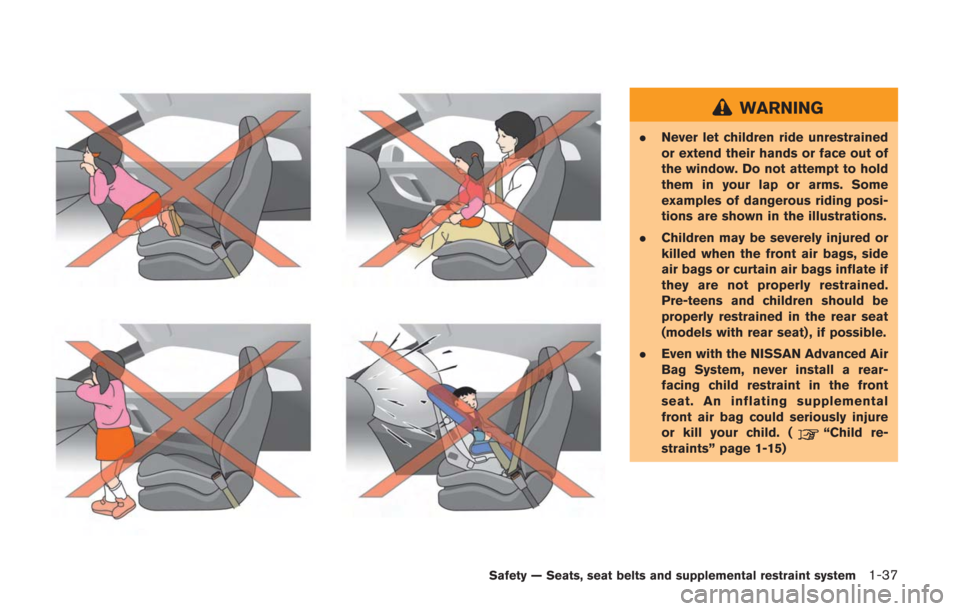
WARNING
.Never let children ride unrestrained
or extend their hands or face out of
the window. Do not attempt to hold
them in your lap or arms. Some
examples of dangerous riding posi-
tions are shown in the illustrations.
. Children may be severely injured or
killed when the front air bags, side
air bags or curtain air bags inflate if
they are not properly restrained.
Pre-teens and children should be
properly restrained in the rear seat
(models with rear seat) , if possible.
. Even with the NISSAN Advanced Air
Bag System, never install a rear-
facing child restraint in the front
seat. An inflating supplemental
front air bag could seriously injure
or kill your child. (
“Child re-
straints” page 1-15)
Safety — Seats, seat belts and supplemental restraint system1-37
Page 88 of 354

tions are shown in the previous
illustrations.
. When sitting in the rear seat (mod-
els with rear seat) , do not hold onto
the seatback of the front seat. If the
supplemental side air bag inflates,
you may be seriously injured. Be
especially careful with children, who
should always be properly re-
strained. Some examples of danger-
ous riding positions are shown in
the illustrations.
. Do not use seat covers on the front
seatbacks. They may interfere with
side air bag inflation.
1. Crash zone sensor
2. Supplemental front-impact air bag modules
(NISSAN Advanced Air Bag System)
3. Front seat-mounted side-impact supplemental air bags
4. Roof-mounted curtain side-impact supplemental air bags 5. Roof-mounted curtain side-impact supplemental
air bag inflators
6. Occupant classification sensor (pattern sensor)
7. Occupant classification system control unit
8. Satellite sensors
9. Seat belt pretensioners
10. Air bag Control Unit (ACU)
Safety — Seats, seat belts and supplemental restraint system1-39
Page 90 of 354
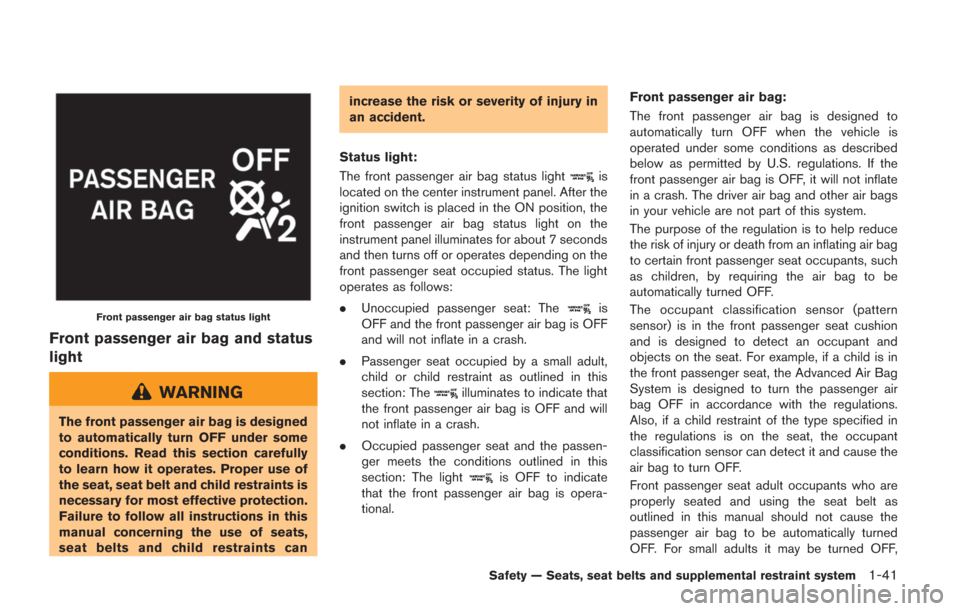
Front passenger air bag status light
Front passenger air bag and status
light
WARNING
The front passenger air bag is designed
to automatically turn OFF under some
conditions. Read this section carefully
to learn how it operates. Proper use of
the seat, seat belt and child restraints is
necessary for most effective protection.
Failure to follow all instructions in this
manual concerning the use of seats,
seat belts and child restraints canincrease the risk or severity of injury in
an accident.
Status light:
The front passenger air bag status light
is
located on the center instrument panel. After the
ignition switch is placed in the ON position, the
front passenger air bag status light on the
instrument panel illuminates for about 7 seconds
and then turns off or operates depending on the
front passenger seat occupied status. The light
operates as follows:
. Unoccupied passenger seat: The
is
OFF and the front passenger air bag is OFF
and will not inflate in a crash.
. Passenger seat occupied by a small adult,
child or child restraint as outlined in this
section: The
illuminates to indicate that
the front passenger air bag is OFF and will
not inflate in a crash.
. Occupied passenger seat and the passen-
ger meets the conditions outlined in this
section: The light
is OFF to indicate
that the front passenger air bag is opera-
tional. Front passenger air bag:
The front passenger air bag is designed to
automatically turn OFF when the vehicle is
operated under some conditions as described
below as permitted by U.S. regulations. If the
front passenger air bag is OFF, it will not inflate
in a crash. The driver air bag and other air bags
in your vehicle are not part of this system.
The purpose of the regulation is to help reduce
the risk of injury or death from an inflating air bag
to certain front passenger seat occupants, such
as children, by requiring the air bag to be
automatically turned OFF.
The occupant classification sensor (pattern
sensor) is in the front passenger seat cushion
and is designed to detect an occupant and
objects on the seat. For example, if a child is in
the front passenger seat, the Advanced Air Bag
System is designed to turn the passenger air
bag OFF in accordance with the regulations.
Also, if a child restraint of the type specified in
the regulations is on the seat, the occupant
classification sensor can detect it and cause the
air bag to turn OFF.
Front passenger seat adult occupants who are
properly seated and using the seat belt as
outlined in this manual should not cause the
passenger air bag to be automatically turned
OFF. For small adults it may be turned OFF,
Safety — Seats, seat belts and supplemental restraint system1-41
Page 91 of 354
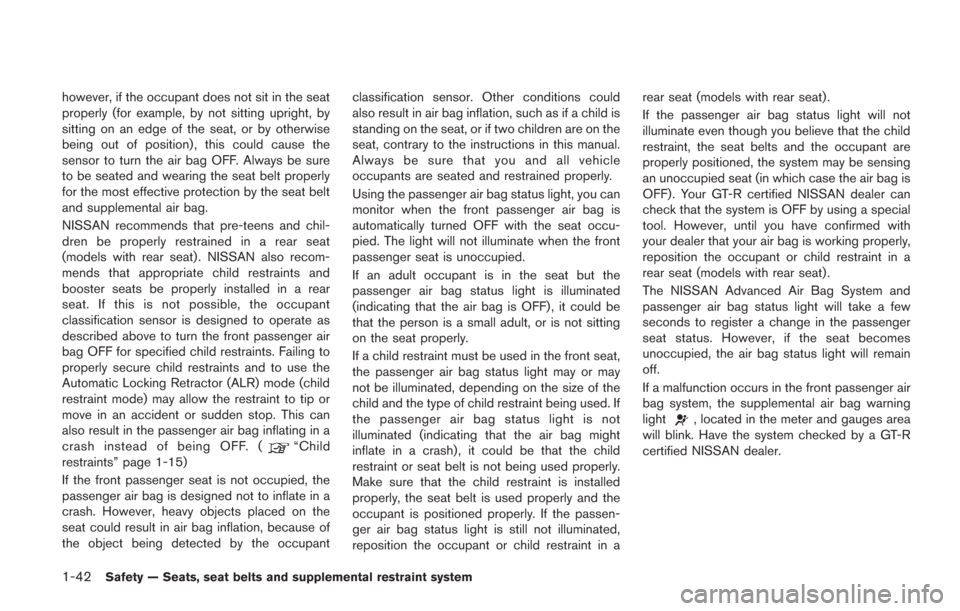
1-42Safety — Seats, seat belts and supplemental restraint system
however, if the occupant does not sit in the seat
properly (for example, by not sitting upright, by
sitting on an edge of the seat, or by otherwise
being out of position) , this could cause the
sensor to turn the air bag OFF. Always be sure
to be seated and wearing the seat belt properly
for the most effective protection by the seat belt
and supplemental air bag.
NISSAN recommends that pre-teens and chil-
dren be properly restrained in a rear seat
(models with rear seat) . NISSAN also recom-
mends that appropriate child restraints and
booster seats be properly installed in a rear
seat. If this is not possible, the occupant
classification sensor is designed to operate as
described above to turn the front passenger air
bag OFF for specified child restraints. Failing to
properly secure child restraints and to use the
Automatic Locking Retractor (ALR) mode (child
restraint mode) may allow the restraint to tip or
move in an accident or sudden stop. This can
also result in the passenger air bag inflating in a
crash instead of being OFF. (
“Child
restraints” page 1-15)
If the front passenger seat is not occupied, the
passenger air bag is designed not to inflate in a
crash. However, heavy objects placed on the
seat could result in air bag inflation, because of
the object being detected by the occupant classification sensor. Other conditions could
also result in air bag inflation, such as if a child is
standing on the seat, or if two children are on the
seat, contrary to the instructions in this manual.
Always be sure that you and all vehicle
occupants are seated and restrained properly.
Using the passenger air bag status light, you can
monitor when the front passenger air bag is
automatically turned OFF with the seat occu-
pied. The light will not illuminate when the front
passenger seat is unoccupied.
If an adult occupant is in the seat but the
passenger air bag status light is illuminated
(indicating that the air bag is OFF) , it could be
that the person is a small adult, or is not sitting
on the seat properly.
If a child restraint must be used in the front seat,
the passenger air bag status light may or may
not be illuminated, depending on the size of the
child and the type of child restraint being used. If
the passenger air bag status light is not
illuminated (indicating that the air bag might
inflate in a crash), it could be that the child
restraint or seat belt is not being used properly.
Make sure that the child restraint is installed
properly, the seat belt is used properly and the
occupant is positioned properly. If the passen-
ger air bag status light is still not illuminated,
reposition the occupant or child restraint in arear seat (models with rear seat) .
If the passenger air bag status light will not
illuminate even though you believe that the child
restraint, the seat belts and the occupant are
properly positioned, the system may be sensing
an unoccupied seat (in which case the air bag is
OFF). Your GT-R certified NISSAN dealer can
check that the system is OFF by using a special
tool. However, until you have confirmed with
your dealer that your air bag is working properly,
reposition the occupant or child restraint in a
rear seat (models with rear seat) .
The NISSAN Advanced Air Bag System and
passenger air bag status light will take a few
seconds to register a change in the passenger
seat status. However, if the seat becomes
unoccupied, the air bag status light will remain
off.
If a malfunction occurs in the front passenger air
bag system, the supplemental air bag warning
light
, located in the meter and gauges area
will blink. Have the system checked by a GT-R
certified NISSAN dealer.
Page 169 of 354
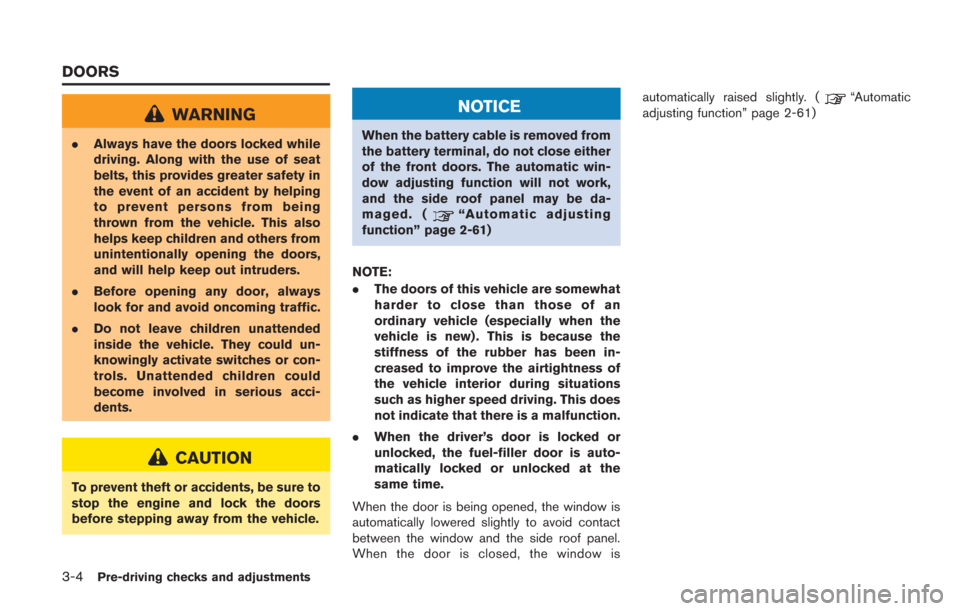
3-4Pre-driving checks and adjustments
WARNING
.Always have the doors locked while
driving. Along with the use of seat
belts, this provides greater safety in
the event of an accident by helping
to prevent persons from being
thrown from the vehicle. This also
helps keep children and others from
unintentionally opening the doors,
and will help keep out intruders.
. Before opening any door, always
look for and avoid oncoming traffic.
. Do not leave children unattended
inside the vehicle. They could un-
knowingly activate switches or con-
trols. Unattended children could
become involved in serious acci-
dents.
CAUTION
To prevent theft or accidents, be sure to
stop the engine and lock the doors
before stepping away from the vehicle.
NOTICE
When the battery cable is removed from
the battery terminal, do not close either
of the front doors. The automatic win-
dow adjusting function will not work,
and the side roof panel may be da-
maged. (
“Automatic adjusting
function” page 2-61)
NOTE:
. The doors of this vehicle are somewhat
harder to close than those of an
ordinary vehicle (especially when the
vehicle is new) . This is because the
stiffness of the rubber has been in-
creased to improve the airtightness of
the vehicle interior during situations
such as higher speed driving. This does
not indicate that there is a malfunction.
. When the driver’s door is locked or
unlocked, the fuel-filler door is auto-
matically locked or unlocked at the
same time.
When the door is being opened, the window is
automatically lowered slightly to avoid contact
between the window and the side roof panel.
When the door is closed, the window is automatically raised slightly. (
“Automatic
adjusting function” page 2-61)
DOORS
Page 200 of 354
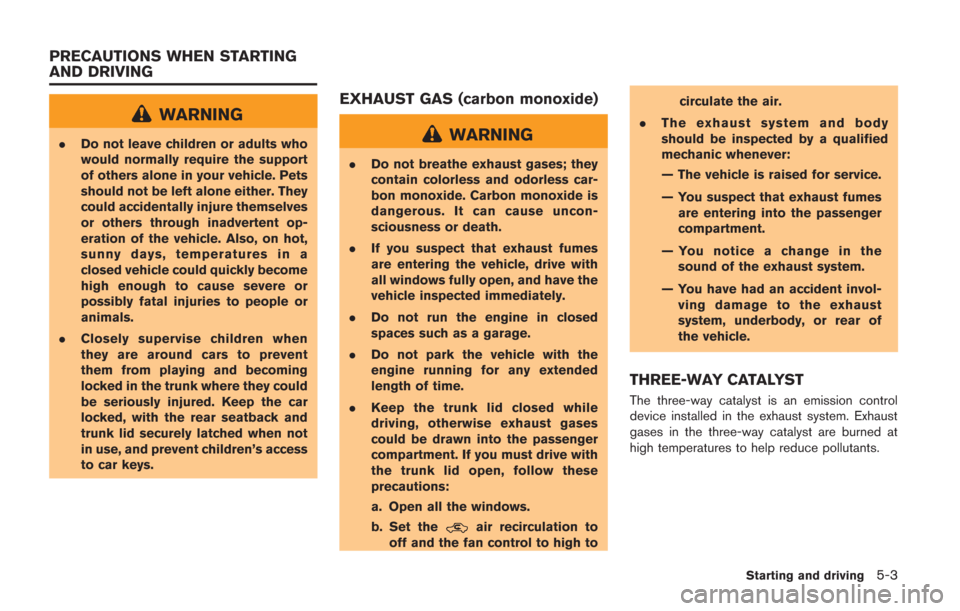
WARNING
.Do not leave children or adults who
would normally require the support
of others alone in your vehicle. Pets
should not be left alone either. They
could accidentally injure themselves
or others through inadvertent op-
eration of the vehicle. Also, on hot,
sunny days, temperatures in a
closed vehicle could quickly become
high enough to cause severe or
possibly fatal injuries to people or
animals.
. Closely supervise children when
they are around cars to prevent
them from playing and becoming
locked in the trunk where they could
be seriously injured. Keep the car
locked, with the rear seatback and
trunk lid securely latched when not
in use, and prevent children’s access
to car keys.
EXHAUST GAS (carbon monoxide)
WARNING
.Do not breathe exhaust gases; they
contain colorless and odorless car-
bon monoxide. Carbon monoxide is
dangerous. It can cause uncon-
sciousness or death.
. If you suspect that exhaust fumes
are entering the vehicle, drive with
all windows fully open, and have the
vehicle inspected immediately.
. Do not run the engine in closed
spaces such as a garage.
. Do not park the vehicle with the
engine running for any extended
length of time.
. Keep the trunk lid closed while
driving, otherwise exhaust gases
could be drawn into the passenger
compartment. If you must drive with
the trunk lid open, follow these
precautions:
a. Open all the windows.
b. Set the
air recirculation to
off and the fan control to high to circulate the air.
. The exhaust system and body
should be inspected by a qualified
mechanic whenever:
— The vehicle is raised for service.
— You suspect that exhaust fumes
are entering into the passenger
compartment.
— You notice a change in the sound of the exhaust system.
— You have had an accident invol- ving damage to the exhaust
system, underbody, or rear of
the vehicle.
THREE-WAY CATALYST
The three-way catalyst is an emission control
device installed in the exhaust system. Exhaust
gases in the three-way catalyst are burned at
high temperatures to help reduce pollutants.
Starting and driving5-3
PRECAUTIONS WHEN STARTING
AND DRIVING
Page 344 of 354
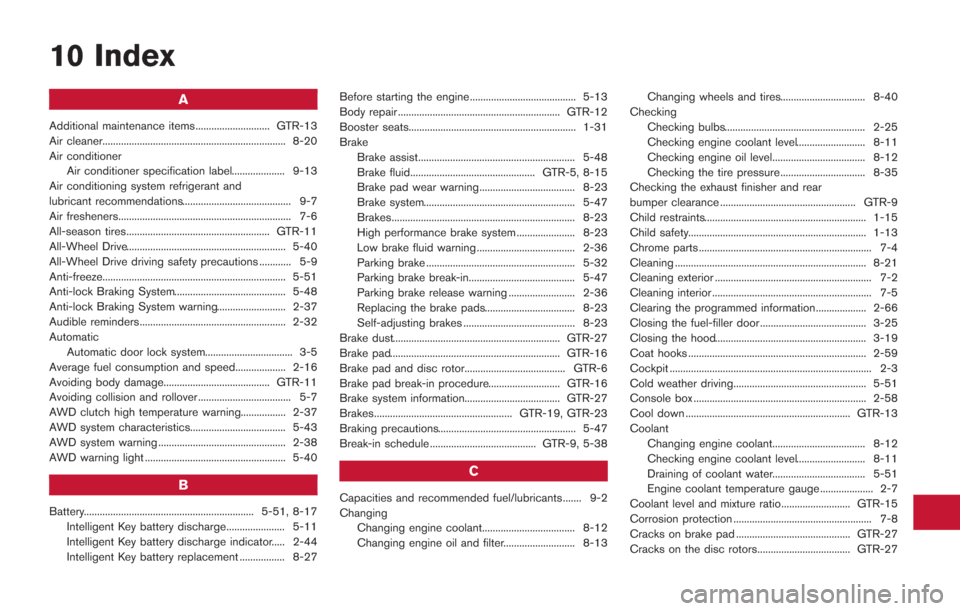
10 Index
A
Additional maintenance items............................ GTR-13
Air cleaner..................................................................... 8-20
Air conditionerAir conditioner specification label.................... 9-13
Air conditioning system refrigerant and
lubricant recommendations......................................... 9-7
Air fresheners................................................................. 7-6
All-season tires...................................................... GTR-11
All-Wheel Drive............................................................ 5-40
All-Wheel Drive driving safety precautions ............ 5-9
Anti-freeze..................................................................... 5-51
Anti-lock Braking System.......................................... 5-48
Anti-lock Braking System warning.......................... 2-37
Audible reminders....................................................... 2-32
Automatic Automatic door lock system................................. 3-5
Average fuel consumption and speed................... 2-16
Avoiding body damage........................................ GTR-11
Avoiding collision and rollover ................................... 5-7
AWD clutch high temperature warning................. 2-37
AWD system characteristics.................................... 5-43
AWD system warning ................................................ 2-38
AWD warning light ..................................................... 5-40
B
Battery................................................................ 5-51, 8-17 Intelligent Key battery discharge...................... 5-11
Intelligent Key battery discharge indicator..... 2-44
Intelligent Key battery replacement ................. 8-27 Before starting the engine........................................ 5-13
Body repair ............................................................. GTR-12
Booster seats............................................................... 1-31
Brake
Brake assist........................................................... 5-48
Brake fluid............................................... GTR-5, 8-15
Brake pad wear warning.................................... 8-23
Brake system......................................................... 5-47
Brakes..................................................................... 8-23
High performance brake system ...................... 8-23
Low brake fluid warning ..................................... 2-36
Parking brake ........................................................ 5-32
Parking brake break-in........................................ 5-47
Parking brake release warning ......................... 2-36
Replacing the brake pads.................................. 8-23
Self-adjusting brakes .......................................... 8-23
Brake dust............................................................... GTR-27
Brake pad................................................................ GTR-16
Brake pad and disc rotor...................................... GTR-6
Brake pad break-in procedure........................... GTR-16
Brake system information.................................... GTR-27
Brakes.................................................... GTR-19, GTR-23
Braking precautions.................................................... 5-47
Break-in schedule ........................................ GTR-9, 5-38
C
Capacities and recommended fuel/lubricants ....... 9-2
Changing Changing engine coolant................................... 8-12
Changing engine oil and filter........................... 8-13 Changing wheels and tires................................ 8-40
Checking Checking bulbs..................................................... 2-25
Checking engine coolant level.......................... 8-11
Checking engine oil level................................... 8-12
Checking the tire pressure................................ 8-35
Checking the exhaust finisher and rear
bumper clearance ................................................... GTR-9
Child restraints............................................................. 1-15
Child safety................................................................... 1-13
Chrome parts ................................................................. 7-4
Cleaning ........................................................................ 8-21
Cleaning exterior ........................................................... 7-2
Cleaning interior ............................................................ 7-5
Clearing the programmed information................... 2-66
Closing the fuel-filler door ........................................ 3-25
Closing the hood......................................................... 3-19
Coat hooks ................................................................... 2-59
Cockpit ............................................................................ 2-3
Cold weather driving.................................................. 5-51
Console box ................................................................. 2-58
Cool down .............................................................. GTR-13
Coolant Changing engine coolant................................... 8-12
Checking engine coolant level.......................... 8-11
Draining of coolant water................................... 5-51
Engine coolant temperature gauge .................... 2-7
Coolant level and mixture ratio.......................... GTR-15
Corrosion protection .................................................... 7-8
Cracks on brake pad ........................................... GTR-27
Cracks on the disc rotors................................... GTR-27
Page 346 of 354
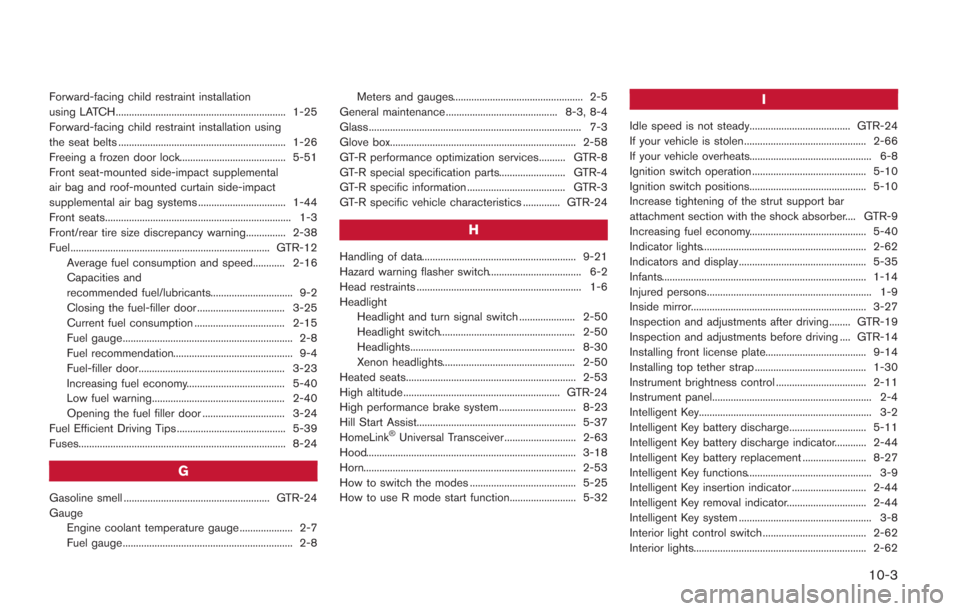
Forward-facing child restraint installation
using LATCH................................................................ 1-25
Forward-facing child restraint installation using
the seat belts ............................................................... 1-26
Freeing a frozen door lock........................................ 5-51
Front seat-mounted side-impact supplemental
air bag and roof-mounted curtain side-impact
supplemental air bag systems ................................. 1-44
Front seats...................................................................... 1-3
Front/rear tire size discrepancy warning............... 2-38
Fuel........................................................................... GTR-12Average fuel consumption and speed............ 2-16
Capacities and
recommended fuel/lubricants............................... 9-2
Closing the fuel-filler door ................................. 3-25
Current fuel consumption .................................. 2-15
Fuel gauge................................................................ 2-8
Fuel recommendation............................................. 9-4
Fuel-filler door....................................................... 3-23
Increasing fuel economy..................................... 5-40
Low fuel warning.................................................. 2-40
Opening the fuel filler door ............................... 3-24
Fuel Efficient Driving Tips ......................................... 5-39
Fuses.............................................................................. 8-24
G
Gasoline smell ....................................................... GTR-24
Gauge Engine coolant temperature gauge .................... 2-7
Fuel gauge................................................................ 2-8 Meters and gauges................................................. 2-5
General maintenance .......................................... 8-3, 8-4
Glass................................................................................ 7-3
Glove box...................................................................... 2-58
GT-R performance optimization services.......... GTR-8
GT-R special specification parts......................... GTR-4
GT-R specific information ..................................... GTR-3
GT-R specific vehicle characteristics .............. GTR-24
H
Handling of data.......................................................... 9-21
Hazard warning flasher switch................................... 6-2
Head restraints .............................................................. 1-6
Headlight Headlight and turn signal switch ..................... 2-50
Headlight switch................................................... 2-50
Headlights.............................................................. 8-30
Xenon headlights.................................................. 2-50
Heated seats................................................................ 2-53
High altitude ........................................................... GTR-24
High performance brake system ............................. 8-23
Hill Start Assist............................................................ 5-37
HomeLink
®Universal Transceiver ........................... 2-63
Hood............................................................................... 3-18
Horn................................................................................ 2-53
How to switch the modes ........................................ 5-25
How to use R mode start function......................... 5-32
I
Idle speed is not steady...................................... GTR-24
If your vehicle is stolen.............................................. 2-66
If your vehicle overheats.............................................. 6-8
Ignition switch operation ........................................... 5-10
Ignition switch positions............................................ 5-10
Increase tightening of the strut support bar
attachment section with the shock absorber.... GTR-9
Increasing fuel economy............................................ 5-40
Indicator lights.............................................................. 2-62
Indicators and display................................................ 5-35
Infants............................................................................. 1-14
Injured persons.............................................................. 1-9
Inside mirror.................................................................. 3-27
Inspection and adjustments after driving........ GTR-19
Inspection and adjustments before driving .... GTR-14
Installing front license plate...................................... 9-14
Installing top tether strap .......................................... 1-30
Instrument brightness control .................................. 2-11
Instrument panel............................................................ 2-4
Intelligent Key................................................................. 3-2
Intelligent Key battery discharge............................. 5-11
Intelligent Key battery discharge indicator............ 2-44
Intelligent Key battery replacement ........................ 8-27
Intelligent Key functions............................................... 3-9
Intelligent Key insertion indicator ............................ 2-44
Intelligent Key removal indicator.............................. 2-44
Intelligent Key system .................................................. 3-8
Interior light control switch ....................................... 2-62
Interior lights................................................................. 2-62
10-3